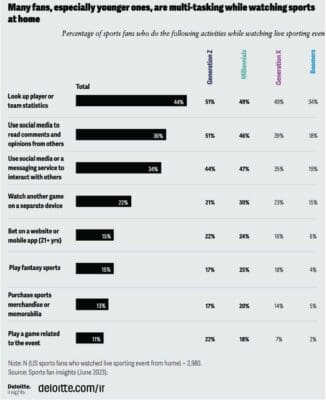In an era where live event media technology is rapidly advancing and the war to win eyeballs between broadcasters, operators and content owners rages on, the world of media processing for premium live event contribution has been undergoing a transformation. Premium live events such as sports have been at the forefront of this evolution, with media technology constantly adapting to address challenges and deliver immersive experiences that captivate audiences. This is built on the foundation of fundamental requirements such as high quality video, near real-time latencies, cost efficient and resilient delivery, plus monetisation strategies (advertising and subscriber models). However, as gamification, social engagement, personalisation, and even advanced in-game technology like Video Assistant Referee (VAR) become integral to modern live sporting events, the industry and the media technology developed must forge new paths to develop media technology that keeps pace with both evolving infrastructure, delivery challenges and consumer engagement – ultimately ensuring subscribers are firmly captivated by premium services.
Embracing gamification and social interaction

The integration of gamification elements within live event broadcasting has breathed new life into traditional sports coverage. Augmented Reality (AR) overlays and interactive graphics allow fans to engage with statistics, trivia, and mini-games during the broadcast/streamed event. This dynamic interaction transforms passive viewers into active participants, fostering a deeper sense of connection with the event. Social media integration further amplifies engagement, enabling fans to share their thoughts, reactions, and even compete with friends in real-time. As the graph from the June 2023 Sport fan insight report published by Deloitte indicates, social interactivity and other related activities whilst engaging in sports is a large part of the overall experience. The same report also cites other appealing features include watching the game from an athlete’s POV, co-viewing with friends and family, and behind-the-scenes content from athletes. As media technology evolves, broadcasters and content owners must enable the seamless integration of gamified elements and social platforms to ensure a holistic and engaging experience.
Personalisation for individual experiences
Today’s consumers are becoming tuned in to personalised experiences across all facets of their lives, including live event broadcasts. Media processing technology is rising to the challenge by enabling broadcasters to offer tailored content to different viewer segments. Whether it’s choosing between multiple camera angles, selecting commentary options, or receiving real-time notifications about player statistics, personalisation enhances engagement by catering to individual preferences. Technological advances such as AI and machine learning enable the creation of custom viewing experiences, ensuring that each viewer feels catered to in a crowded digital landscape. All too often the User Interface (UI) is at the centre of the user experience for these new tailored experiences, although the entire chain of delivery for this content can be affected, in order to provide clarity for the true impact and balance between the cost and benefit. These new additional services can have an impact on the bandwidth and operational cost required and must be considered when reviewing the cost efficiency of the technology to deliver them to the audience.
Revolutionising game technology
Game-changing technologies like slow-motion replays and VAR have redefined the way audiences experience live events and aid in-game decisioning. Slow-motion replays offer an in-depth analysis of key moments, providing viewers with a closer look at intricate details and allowing for a more comprehensive understanding of the game’s dynamics. VAR, on the other hand, has added an extra layer of fairness to sports, minimising controversies by reviewing critical decisions using advanced video analysis. To adapt to these technological demands, media processing must ensure real-time, cost efficient delivery of these features without compromising on video quality or user experience.
Adapting to ever-evolving consumer experiences
The biggest challenge for media processing technology lies in its ability to adapt swiftly to ever-evolving consumer experiences and in-game aids to level the playing field. With technology’s rapid pace, staying ahead requires a flexible architecture that can seamlessly incorporate new features and formats. It is important for broadcasters, operators and content owners to consider the delivery of such innovations to a smaller audience initially before rolling out at scale. This must be considered and managed carefully in terms of deployment.
The debate still rages on regarding the question of processing and delivery infrastructure. The decision of cloud, dedicated on-premise hardware or a hybrid approach as the most optimal and efficient processing, delivery and transport mechanism is really linked to the type of contribution application and workflow required to deliver the end consumer experience.
As consumer expectations shift towards immersive 8K resolution, VR/AR integration, and even holographic displays, live media content and how it is efficiently processed, transported and deployed, must be able to accommodate these advancements. There is also the question of the impact of industry standards throughout the media delivery workflows needed to enable these new experiences.
Conclusion
The landscape of media technology for premium live event contribution, such as sports, is undergoing a significant transformation, propelled by the need to cater to evolving consumer experiences. From gamification and social interaction to personalised viewing options and revolutionary game technology, the industry is pushing the boundaries to create more engaging and immersive experiences. To succeed in this endeavour, media processing and delivery technology must remain adaptable but adhere to a standards approach, leveraging the most efficient and optimal deployment architecture solutions (cloud, on-premise or hybrid) and emerging technologies to seamlessly integrate novel features while maintaining the highest standards of quality and reliability. As the world continues to embrace technological innovation, the future of premium live event content contribution promises a captivating journey for both media service providers and viewers alike.
To find out more about how Appear is enabling the future of premium live event experiences please click here




